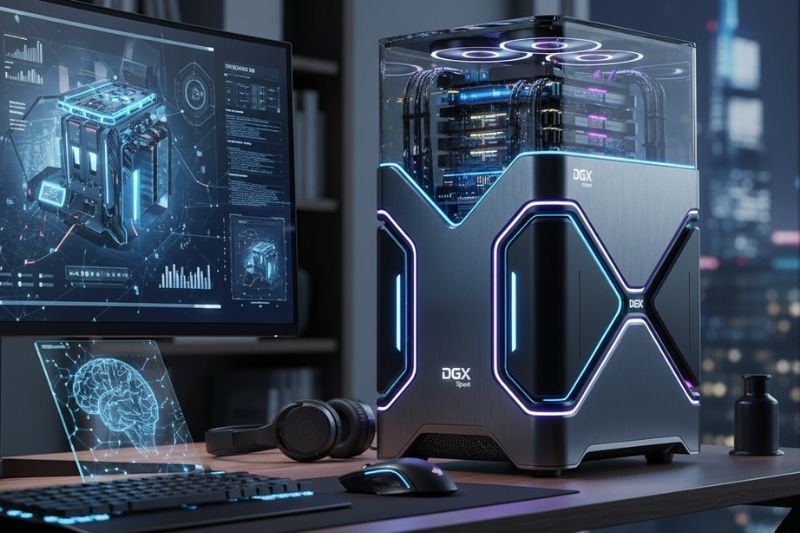The launch of DGX Spark marks a watershed moment in AI democratization, enabling desktop-scale supercomputing. In a symbolic reprise, Nvidia CEO Jensen Huang personally delivered the first unit to Elon Musk at SpaceX’s Starbase, echoing the 2016 DGX-1 delivery to Musk’s then-startup OpenAI.
A Historic Hand-Delivered Moment
To emphasize its mission, Jensen Huang hand-delivered the first DGX Spark unit to Elon Musk in Texas, replicating the DGX-1 delivery to OpenAI in 2016. This gesture underscores Nvidia’s narrative of placing AI supercomputing directly into developers’ hands.
Time Magazine Recognition & Price
Thanks to its bold design and technical punch, DGX Spark was named one of TIME Magazine’s Best Inventions of 2025. It will be available starting October 15 for $3,999. Early pricing expectations pegged it at $3,000, but Nvidia raised it by ~33 %.
Shipping & Partner Ecosystem
Sales will commence via Nvidia.com and partner OEMs including Acer, ASUS, Dell, GIGABYTE, HP, Lenovo, MSI. Users can expand capabilities by linking two DGX Spark units to work on models up to 405 billion parameters.
Architecture & Performance Capabilities
Understanding the design and performance of DGX Spark reveals why it’s drawing so much attention. Its core lies in the GB10 Grace Blackwell Superchip, built for unified compute on a tiny form factor.
GB10 Grace Blackwell Superchip
At the system’s heart is Nvidia’s GB10 Grace Blackwell architecture, combining an Arm CPU with a Blackwell GPU in a single chip package. This integration enables tight coupling and memory coherence for AI workloads.
Compute Performance & Memory
DGX Spark delivers up to 1 petaflop of AI performance (under FP4, leveraging sparsity) and houses 128 GB of unified memory. This allows inference on AI models with up to 200 billion parameters, and local fine-tuning of models up to 70 billion parameters.
Connectivity & Expandability
- It incorporates NVIDIA ConnectX-7 networking with up to 200 Gb/s bandwidth.
- Two DGX Spark units can be clustered via NVLink-C2C / RDMA to handle models up to 405 billion parameters.
- Storage is supported via up to 4 TB NVMe, and form factor is ultra compact (~150 mm × 150 mm × 50.5 mm).
Efficiency & Power Envelope
Despite supercomputer-level performance, DGX Spark is relatively power-efficient, running in the ballpark of ~240 watts for full load.
Developer Ecosystem & Use Cases
The DGX Spark is not just hardware — it ships with Nvidia’s AI software stack, bridging prototype to deployment. It appeals to AI researchers, startups, and teams seeking on-premises AI experimentation.
Preinstalled AI Stack & Local Workflows
DGX Spark comes with DGX OS, CUDA libraries, and Nvidia AI software by default. This makes onboarding easier: users can prototype locally, then scale to DGX Cloud or enterprise DGX infrastructure without rewriting code.
Early Recipients & Validation
Major tech firms and research institutions are early adopters: Google, Meta, Microsoft, Hugging Face, Docker, NYU’s Global Frontier Lab and more.
Example Use Cases
- Local fine-tuning: Teams can fine-tune 70B-parameter models offline, without cloud cost or latency.
- Inference at scale: Run inference on 200B parameter models with latency advantage.
- AI agent development: Build embodied or multi-agent workflows locally before cloud deployment.
- Privacy-sensitive AI: Work with sensitive datasets when cloud compliance is an issue.
- Simulation & robotics control: Use DGX Spark for real-time physical AI, digital twins, or control systems.
Limitations & Community Notes
Some community voices caution that DGX Spark is still in early stage: performance may be limited for full production workloads, and memory or bandwidth may become bottlenecks.
Market Impact & Broader AI Trends
The advent of a desktop AI supercomputer like DGX Spark signals shifting paradigms in how AI compute is provisioned and democratized.
Democratizing AI Compute
By putting petascale compute on the desk, Nvidia is reducing dependence on cloud-only AI workflows. This could lower entry barriers for AI research and startups worldwide.
Competitive Positioning
DGX Spark directly competes—or complements—cloud GPU offerings. In benchmarks, Blackwell architecture reportedly exceeds performance of Apple’s M3 Ultra GPU in raw compute metrics.
Scaling & Data Center Integration
Users can prototype on DGX Spark and then scale to DGX Cloud or rack DGX systems seamlessly. This hybrid model aligns with Nvidia’s ecosystem strategy.
AI Infrastructure in Context
When compared to massive AI infrastructure systems like Isambard-AI (21 exaflops) or Japan’s ABCI 3.0 (3 exaflops), DGX Spark is niche but strategic — enabling edge and desktop compute complementing hyperscale systems.
Adoption Challenges
- The $3,999 price point is still steep for many researchers or small teams.
- Thermal, cooling, and continuous long-run reliability remain tests for a desktop device.
- Workloads beyond inference or moderate training may require more memory or bandwidth than Spark offers.
Future Roadmap & Strategic Vision
What comes next for DGX Spark, and how might Nvidia expand its footprint in AI computing?
DGX Station & Larger Chips
Nvidia has also announced DGX Station, aimed at higher performance and bigger memory, as a complement to Spark.
OEM Variants & Desktop AI PCs
OEM partners like ASUS, HP, Dell, MSI will offer custom DGX Spark systems, integrating into familiar desktop form factors.
Clusters of Spark Units
While officially two-unit clusters are supported, users may experiment with chaining many units for larger aggregate models.
Moves Into Edge & Embedded AI
A compact AI supercomputer opens paths for future edge, robotics, and embedded AI use cases that never before could host petascale compute.
Software & Model Optimization
Nvidia and the AI community will likely adapt and optimize models to run more efficiently on Spark’s architecture, squeezing more from limited memory and compute.
Conclusion
The DGX Spark desktop AI supercomputer heralds a new frontier: bringing petascale AI power out of data centers and onto developers’ desks. With 1 petaflop performance, 128 GB unified memory, support for massive models, and expandability via clustering, DGX Spark could reshape how AI is prototyped and deployed. While challenges remain—cost, thermal constraints, production readiness—the symbolic handover and ambitious specs mark it as a pivotal milestone in AI infrastructure. As Nvidia continues into DGX Station and OEM desktops, the era of supercomputing everywhere may be closer than we think.
Keep your eyes on Trending Eyes for real-time insights and analysis.
Post Views: 32





